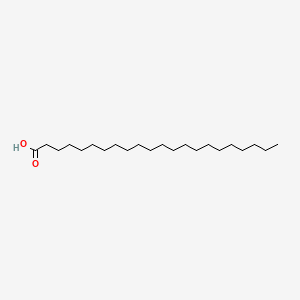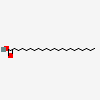Behenic Acid
- Docosanoic acid
- Behenic acid
- 112-85-6
- 1-Docosanoic acid
- N-DOCOSANOIC ACID
- Create:2004-09-16
- Modify:2025-01-18

16529-65-0 (zinc salt)
18990-72-2 (aluminum salt)
20259-31-8 (iron(+3) salt)
2489-05-6 (silver(+1) salt)
2636-16-0 (barium salt)
34303-23-6 (cadmium salt)
4499-91-6 (lithium salt)
5331-77-1 (hydrochloride salt)
- behenic acid
- behenic acid, aluminum salt
- behenic acid, barium salt
- behenic acid, cadmium salt
- behenic acid, ferrium (+3) salt
- behenic acid, lithium salt
- behenic acid, potassium salt
- behenic acid, silver (+1) salt
- behenic acid, sodium salt
- behenic acid, zinc salt
- docosanoic acid
- Docosanoic acid
- Behenic acid
- 112-85-6
- 1-Docosanoic acid
- N-DOCOSANOIC ACID
- Hydrofol Acid 560
- Hydrofol 2022-55
- Glycon B-70
- Docosoic acid
- Hystrene 5522
- Hystrene 9022
- Glycon B 70
- Prifrac 2989
- Behensaeure
- Docosansaeure
- Dokosansaeure
- Docosanic acid
- CHEBI:28941
- HSDB 5578
- Edenor C 22-85R
- EINECS 204-010-8
- NSC 32364
- UNII-H390488X0A
- CRODACID B
- ORISTAR BA
- AI3-52709
- C22:0
- MFCD00002807
- NSC-32364
- H390488X0A
- EXL 5
- PRIFRAC 2987
- NAA 22S
- NAA 222S
- DTXSID3026930
- Docosanoic acid (Chunks or pellets or flakes)
- EC 204-010-8
- NSC32364
- FA 22:0
- B 95
- CH3-(CH2)20-COOH
- CH3-[CH2]20-COOH
- n-Docosanoate
- 1-Docosanoate
- docosanoyl alcohol
- fatty acid 22:0
- Behenic acid, 99%
- Prifac 2987
- Behenic Acid, Technical
- Docosanoic acid, ?99%
- BEHENIC ACID [MI]
- SCHEMBL6579
- EXL-5
- Behenic acid; Docosanoic acid
- DOCOSANOIC ACID [HSDB]
- DTXCID306930
- CHEMBL1173474
- AGP-103
- Behenic acid, analytical standard
- BBL025601
- BDBM50488776
- LMFA01010022
- s5381
- STL146320
- AKOS005720830
- CCG-267927
- CS-W013765
- HY-W013049
- NCGC00475914-02
- AS-54401
- B-95
- B1248
- B1747
- D0963
- NS00005465
- C08281
- P50011
- Q422590
- W-108636
- BEHENIC ACID (CONSTITUENT OF BORAGE SEED OIL)
- BRD-K91495480-001-02-2
- E2AAC59F-4B8D-460C-9C6E-E4E82C905122
- 08O
43.0 99.99
57.0 70.20
41.0 70.10
60.0 69.40
73.0 65.60
117.0 100
132.0 53.75
129.0 46.05
145.0 31.63
133.0 14.31
339.3276 100
340.33 21.72
339.3276 100
340.3303 23.42
341.3316 1
339.3281 999
101.2462 2
337.3147 2
319.2998 1
339.3275 999
321.3147 9
241.2877 1
43 999
57 702
41 701
60 694
73 656
- Extracellular
- Membrane
 Green circle - The chemical has been verified to be of low concern
Green circle - The chemical has been verified to be of low concern- Lubricants and lubricant additives
- Intermediates
- Emulsifier
- Intermediate
- Fuel
- Other
- Softener and conditioner
- Lubricating agent
- Solids separation agents
- Solids separation agents
- Paint additives and coating additives not described by other categories
- Softener and conditioner
- Lubricating agent
- Other
- Emulsifier
- Not Known or Reasonably Ascertainable
- Lubricants and lubricant additives
Information on 33 consumer products that contain Behenic acid in the following categories is provided:
• Personal Care
2019: 1,000,000 lb - <20,000,000 lb
2018: 1,000,000 lb - <20,000,000 lb
2017: 1,000,000 lb - <20,000,000 lb
2016: 1,000,000 lb - <20,000,000 lb
- Paper Manufacturing
- Plastics Product Manufacturing
- All Other Chemical Product and Preparation Manufacturing
- Soap, Cleaning Compound, and Toilet Preparation Manufacturing
- Cyclic Crude and Intermediate Manufacturing
- Petroleum Lubricating Oil and Grease Manufacturing
- All Other Basic Organic Chemical Manufacturing
- Other (requires additional information)
Not Classified
Reported as not meeting GHS hazard criteria by 168 of 173 companies (only 2.9% companies provided GHS information). For more detailed information, please visit ECHA C&L website.
Aggregated GHS information provided per 173 reports by companies from 2 notifications to the ECHA C&L Inventory.
Reported as not meeting GHS hazard criteria per 168 of 173 reports by companies. For more detailed information, please visit ECHA C&L website.
There is 1 notification provided by 5 of 173 reports by companies with hazard statement code(s).
Information may vary between notifications depending on impurities, additives, and other factors. The percentage value in parenthesis indicates the notified classification ratio from companies that provide hazard codes. Only hazard codes with percentage values above 10% are shown.
Chemical: Docosanoic acid

Status: Active Update: 29-06-2022 https://echa.europa.eu/registration-dossier/-/registered-dossier/14201
Status: Active Update: 19-07-2021 https://echa.europa.eu/registration-dossier/-/registered-dossier/32680
IMAP assessments - Docosanoic acid: Human health tier I assessment
IMAP assessments - Docosanoic acid: Environment tier I assessment
Silke Matysik, Caroline Ivanne Le Roy, Gerhard Liebisch, Sandrine Paule Claus. Metabolomics of fecal samples: A practical consideration. Trends in Food Science & Technology. Vol. 57, Part B, Nov. 2016, p.244-255: http://www.sciencedirect.com/science/article/pii/S0924224416301984
Metabolomics reveals determinants of weight loss during lifestyle intervention in obese children
Patents are available for this chemical structure:
https://patentscope.wipo.int/search/en/result.jsf?inchikey=UKMSUNONTOPOIO-UHFFFAOYSA-N
- Australian Industrial Chemicals Introduction Scheme (AICIS)
- CAS Common ChemistryLICENSEThe data from CAS Common Chemistry is provided under a CC-BY-NC 4.0 license, unless otherwise stated.https://creativecommons.org/licenses/by-nc/4.0/Docosanoic acidhttps://commonchemistry.cas.org/detail?cas_rn=112-85-6
- ChemIDplusChemIDplus Chemical Information Classificationhttps://pubchem.ncbi.nlm.nih.gov/source/ChemIDplus
- DTP/NCILICENSEUnless otherwise indicated, all text within NCI products is free of copyright and may be reused without our permission. Credit the National Cancer Institute as the source.https://www.cancer.gov/policies/copyright-reuse
- EPA Chemical Data Reporting (CDR)LICENSEThe U.S. Government retains a nonexclusive, royalty-free license to publish or reproduce these documents, or allow others to do so, for U.S. Government purposes. These documents may be freely distributed and used for non-commercial, scientific and educational purposes.https://www.epa.gov/web-policies-and-procedures/epa-disclaimers#copyrightDocosanoic acidhttps://www.epa.gov/chemical-data-reporting
- EPA Chemicals under the TSCADocosanoic acidhttps://www.epa.gov/chemicals-under-tscaEPA TSCA Classificationhttps://www.epa.gov/tsca-inventory
- EPA DSSToxDocosanoic acidhttps://comptox.epa.gov/dashboard/DTXSID3026930CompTox Chemicals Dashboard Chemical Listshttps://comptox.epa.gov/dashboard/chemical-lists/
- European Chemicals Agency (ECHA)LICENSEUse of the information, documents and data from the ECHA website is subject to the terms and conditions of this Legal Notice, and subject to other binding limitations provided for under applicable law, the information, documents and data made available on the ECHA website may be reproduced, distributed and/or used, totally or in part, for non-commercial purposes provided that ECHA is acknowledged as the source: "Source: European Chemicals Agency, http://echa.europa.eu/". Such acknowledgement must be included in each copy of the material. ECHA permits and encourages organisations and individuals to create links to the ECHA website under the following cumulative conditions: Links can only be made to webpages that provide a link to the Legal Notice page.https://echa.europa.eu/web/guest/legal-noticeDocosanoic acidhttps://chem.echa.europa.eu/100.003.646Docosanoic acid (EC: 204-010-8)https://echa.europa.eu/information-on-chemicals/cl-inventory-database/-/discli/details/77327
- FDA Global Substance Registration System (GSRS)LICENSEUnless otherwise noted, the contents of the FDA website (www.fda.gov), both text and graphics, are not copyrighted. They are in the public domain and may be republished, reprinted and otherwise used freely by anyone without the need to obtain permission from FDA. Credit to the U.S. Food and Drug Administration as the source is appreciated but not required.https://www.fda.gov/about-fda/about-website/website-policies#linking
- Hazardous Substances Data Bank (HSDB)DOCOSANOIC ACIDhttps://pubchem.ncbi.nlm.nih.gov/source/hsdb/5578
- Human Metabolome Database (HMDB)LICENSEHMDB is offered to the public as a freely available resource. Use and re-distribution of the data, in whole or in part, for commercial purposes requires explicit permission of the authors and explicit acknowledgment of the source material (HMDB) and the original publication (see the HMDB citing page). We ask that users who download significant portions of the database cite the HMDB paper in any resulting publications.http://www.hmdb.ca/citingBehenic acidhttp://www.hmdb.ca/metabolites/HMDB0000944HMDB0000944_cms_29501https://hmdb.ca/metabolites/HMDB0000944#spectra
- New Zealand Environmental Protection Authority (EPA)LICENSEThis work is licensed under the Creative Commons Attribution-ShareAlike 4.0 International licence.https://www.epa.govt.nz/about-this-site/general-copyright-statement/
- Baker Lab, Chemistry Department, The University of North Carolina at Chapel HillFA 22:0CCS Classification - Baker Labhttps://tarheels.live/bakerlab/
- CCSbaseCCSbase Classificationhttps://ccsbase.net/
- LIPID MAPSLipid Classificationhttps://www.lipidmaps.org/
- ChEBIDocosanoic acidhttps://www.ebi.ac.uk/chebi/searchId.do?chebiId=CHEBI:28941
- LOTUS - the natural products occurrence databaseLICENSEThe code for LOTUS is released under the GNU General Public License v3.0.https://lotus.nprod.net/Docosanoic acidhttps://www.wikidata.org/wiki/Q422590LOTUS Treehttps://lotus.naturalproducts.net/
- NCI Thesaurus (NCIt)LICENSEUnless otherwise indicated, all text within NCI products is free of copyright and may be reused without our permission. Credit the National Cancer Institute as the source.https://www.cancer.gov/policies/copyright-reuseNCI Thesaurushttps://ncit.nci.nih.gov
- ChEMBLLICENSEAccess to the web interface of ChEMBL is made under the EBI's Terms of Use (http://www.ebi.ac.uk/Information/termsofuse.html). The ChEMBL data is made available on a Creative Commons Attribution-Share Alike 3.0 Unported License (http://creativecommons.org/licenses/by-sa/3.0/).http://www.ebi.ac.uk/Information/termsofuse.htmlChEMBL Protein Target Treehttps://www.ebi.ac.uk/chembl/g/#browse/targets
- Consumer Product Information Database (CPID)LICENSECopyright (c) 2024 DeLima Associates. All rights reserved. Unless otherwise indicated, all materials from CPID are copyrighted by DeLima Associates. No part of these materials, either text or image may be used for any purpose other than for personal use. Therefore, reproduction, modification, storage in a retrieval system or retransmission, in any form or by any means, electronic, mechanical or otherwise, for reasons other than personal use, is strictly prohibited without prior written permission.https://www.whatsinproducts.com/contents/view/1/6Consumer Products Category Classificationhttps://www.whatsinproducts.com/
- Cosmetic Ingredient Review (CIR)
- EPA Chemical and Products Database (CPDat)Docosanoic acidhttps://comptox.epa.gov/dashboard/DTXSID3026930#exposureEPA CPDat Classificationhttps://www.epa.gov/chemical-research/chemical-and-products-database-cpdat
- Haz-Map, Information on Hazardous Chemicals and Occupational DiseasesLICENSECopyright (c) 2022 Haz-Map(R). All rights reserved. Unless otherwise indicated, all materials from Haz-Map are copyrighted by Haz-Map(R). No part of these materials, either text or image may be used for any purpose other than for personal use. Therefore, reproduction, modification, storage in a retrieval system or retransmission, in any form or by any means, electronic, mechanical or otherwise, for reasons other than personal use, is strictly prohibited without prior written permission.https://haz-map.com/AboutBehenic acidhttps://haz-map.com/Agents/3491
- NORMAN Suspect List ExchangeLICENSEData: CC-BY 4.0; Code (hosted by ECI, LCSB): Artistic-2.0https://creativecommons.org/licenses/by/4.0/NORMAN Suspect List Exchange Classificationhttps://www.norman-network.com/nds/SLE/
- ECI Group, LCSB, University of Luxembourgdocosanoic acid
- KNApSAcK Species-Metabolite Database
- Natural Product Activity and Species Source (NPASS)
- West Coast Metabolomics Center-UC DavisFA 22:0; (behenic acid)
- EPA Safer ChoiceDocosanoic acidhttps://www.epa.gov/saferchoice/safer-ingredientsEPA Safer Chemical Ingredients Classificationhttps://www.epa.gov/saferchoice
- FooDBLICENSEFooDB is offered to the public as a freely available resource. Use and re-distribution of the data, in whole or in part, for commercial purposes requires explicit permission of the authors and explicit acknowledgment of the source material (FooDB) and the original publication.https://foodb.ca/aboutBehnic acidhttps://foodb.ca/compounds/FDB005830
- MassBank Europe
- MassBank of North America (MoNA)LICENSEThe content of the MoNA database is licensed under CC BY 4.0.https://mona.fiehnlab.ucdavis.edu/documentation/license
- NIST Mass Spectrometry Data CenterLICENSEData covered by the Standard Reference Data Act of 1968 as amended.https://www.nist.gov/srd/public-lawDocosanoic acidhttp://www.nist.gov/srd/nist1a.cfm
- SpectraBaseFatty acid (Behenic)https://spectrabase.com/spectrum/AaR9KZUUskGFatty acid (Behenic)https://spectrabase.com/spectrum/JmylHVCCXJeBehenic acidhttps://spectrabase.com/spectrum/9Df2qvCE8stDOCOSANOIC ACIDhttps://spectrabase.com/spectrum/GaE0iMSabGaDocosanoic acidhttps://spectrabase.com/spectrum/1lVpw9ubliuBEHENIC ACIDhttps://spectrabase.com/spectrum/BtIPYpmBljYBehenic acidhttps://spectrabase.com/spectrum/60fCYeL1n1FBehenic acidhttps://spectrabase.com/spectrum/8dBfD0Uqn93Behenic acidhttps://spectrabase.com/spectrum/Hl7gs1hJxU2HYSTRENE 9022https://spectrabase.com/spectrum/IHKEAGwBjFNHYSTRENE 5522https://spectrabase.com/spectrum/7u0WCXsLzzK
- Japan Chemical Substance Dictionary (Nikkaji)
- KEGGLICENSEAcademic users may freely use the KEGG website. Non-academic use of KEGG generally requires a commercial licensehttps://www.kegg.jp/kegg/legal.htmlCompounds with biological roleshttp://www.genome.jp/kegg-bin/get_htext?br08001.kegPhytochemical compoundshttp://www.genome.jp/kegg-bin/get_htext?br08003.keg
- MarkerDBLICENSEThis work is licensed under a Creative Commons Attribution-NonCommercial 4.0 International License.https://markerdb.ca/Behenic acidhttps://markerdb.ca/chemicals/495
- Metabolomics Workbench
- NLM RxNorm TerminologyLICENSEThe RxNorm Terminology is created by the National Library of Medicine (NLM) and is in the public domain and may be republished, reprinted and otherwise used freely by anyone without the need to obtain permission from NLM. Credit to the U.S. National Library of Medicine as the source is appreciated but not required. The full RxNorm dataset requires a free license.https://www.nlm.nih.gov/research/umls/rxnorm/docs/termsofservice.htmlbehenic acidhttps://rxnav.nlm.nih.gov/id/rxnorm/1368203
- Protein Data Bank in Europe (PDBe)
- RCSB Protein Data Bank (RCSB PDB)LICENSEData files contained in the PDB archive (ftp://ftp.wwpdb.org) are free of all copyright restrictions and made fully and freely available for both non-commercial and commercial use. Users of the data should attribute the original authors of that structural data.https://www.rcsb.org/pages/policies
- Springer Nature
- Thieme ChemistryLICENSEThe Thieme Chemistry contribution within PubChem is provided under a CC-BY-NC-ND 4.0 license, unless otherwise stated.https://creativecommons.org/licenses/by-nc-nd/4.0/
- Wikidatabehenic acidhttps://www.wikidata.org/wiki/Q422590
- WikipediaAmmonium perrhenatehttps://en.wikipedia.org/wiki/Ammonium_perrhenateBehenic acidhttps://en.wikipedia.org/wiki/Behenic_acid
- PubChem
- Medical Subject Headings (MeSH)LICENSEWorks produced by the U.S. government are not subject to copyright protection in the United States. Any such works found on National Library of Medicine (NLM) Web sites may be freely used or reproduced without permission in the U.S.https://www.nlm.nih.gov/copyright.htmlbehenic acidhttps://www.ncbi.nlm.nih.gov/mesh/67007547
- GHS Classification (UNECE)GHS Classification Treehttp://www.unece.org/trans/danger/publi/ghs/ghs_welcome_e.html
- EPA Substance Registry ServicesEPA SRS List Classificationhttps://sor.epa.gov/sor_internet/registry/substreg/LandingPage.do
- MolGenieMolGenie Organic Chemistry Ontologyhttps://github.com/MolGenie/ontology/
- PATENTSCOPE (WIPO)SID 403380446https://pubchem.ncbi.nlm.nih.gov/substance/403380446
- NCBI










